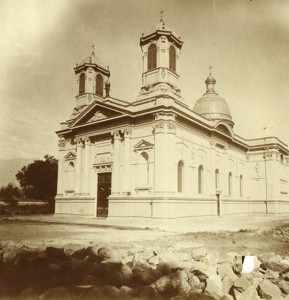
In: http://www.flickriver.com/photos/28047774@N04/4873143201/
In 1853, Archbishop Rafael Valdivieso buys part of the farm Quinta Alegre and other neighboring lands to establish the Seminary of Santiago. These lands that were acquired are characterized by their abundant vegetation, clean air and their proximity to Santiago and were located between the current Rancagua, Providencia, Condell and Seminario Streets, where the Conciliar Seminary was initially built for the spiritual formation of priests for almost a century.
The Spanish architect Manuel Calvo was in charge of the work and designed the first chapel, the rooms of the seminarians and quarters. The construction of the building started under the direction of the vice-chancellor of the seminary, Monsignor Larraín Gandarillas, who was familiar with some convents and European seminaries from which he got some ideas to add to the new construction. He added beautiful gardens, a pool to practice swimming, a soccer field (the first one in the city and in the country) and a lake surrounded by trees and exuberant vegetation.
In 1884, Monsignor Casanova orders the construction of a new temple for the Seminary, since the old chapel, in time, became too tight and small. Taking advantage of the trip made to Chile by the Italian architect Ignacio Cremonesi, he is entrusted with the design of the new church for the Seminary, which would be used only by the clergy and the seminarians.
Cremonesi applies a romantic style, the interior is formed by three naves and, in the same manner as the Cathedral, the ceiling is abundantly ornamented and the lateral walls have beautiful German stained glass windows. The old chapel became the Seminary library and had more than 30,000 books and manuscripts.
The Seminario Conciliar de los Ángeles Custodios remained in that location until 1955. Although the property began to be too small for their use, up to the start of the XX Century, until a new construction was built on the other side of the city. It was preserved to service the parishioners in the sector and it safeguards pieces from the old 1857 chapel, such as the high altar, the imagery in furnace-heated gilded wood of the Adoring Angels and the bronze lamp of the Holy Sacrament.